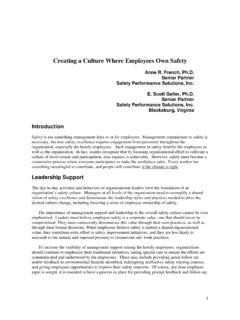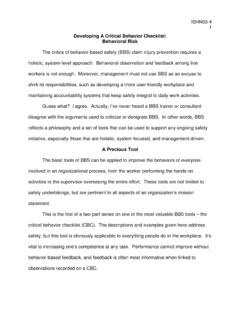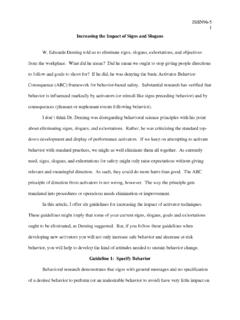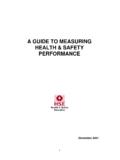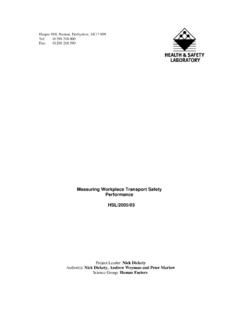Transcription of Increasing Management Support for Safety
1 Improving Management Support for Safety to Optimize Safety Culture, Part 1 Josh Williams, Senior Project Manager Safety performance Solutions { HYPERLINK " " } { HYPERLINK } Introduction Organizational Safety cultures have improved immensely over the years. The Journal of the American Medical Association (1999) estimates that occupational fatalities decreased by more than 90% from 1933-1997. This is largely due to increased cooperation between Management and labor to improve Safety , the development of federal agencies to improve Safety ( , OSHA), and an overall emphasis on improving workplace conditions ( , supplying Safety harnesses) and Safety culture.
2 Unfortunately, some companies have hit a plateau in terms of Safety performance in recent years. Optimizing Management Support for Safety is a key ingredient for Safety culture improvement and the further reduction of injuries. Part 1 of this article provides some general managerial recommendations with an emphasis on improving Safety Management systems ( , training, incentives) to optimize Safety culture. Part 2 of this article (to appear next) examines specific Management behaviors ( , empower employees, praise safe work practices) to improve Safety culture.
3 Management Support for Safety Managers play a crucial role in developing and maintaining an ideal Safety culture (Geller, 2008, 2005, 2002). This starts with providing a safe work environment and extends to hiring a sufficient number of high quality employees to do the job. Effective managers also ensure that: Safety rules are consistently and fairly enforced. Appropriate personal protective equipment ( , Safety glasses, harnesses) is readily available to employees. Work schedules don t compromise employees Safety ( , excessive overtime, unrealistic production pressure).
4 Management spends sufficient time on the floor interacting with employees. o This increases employee input for Safety . {PAGE }o This shows employees that Management cares. Employees are actively involved in managing Safety efforts. Safety Management systems ( , training, discipline) are in place and effective. Safety Management Systems Employees are more likely to be injured if the organization has Safety Management system failures such as: faulty equipment, insufficient Safety training, unclear Safety policies, non-existent Safety meetings, excessive overtime, inadequate manpower, overemphasis on production (at the expense of Safety ), poor Safety communication, and/or blame-oriented (or inconsistent) discipline procedures.
5 Managers improve Safety culture by working to optimize these Safety Management systems: Near miss reporting: There is a formal process in place to report near misses ( , an unplanned event that did not result in injury but had the potential to do so). Managers/Supervisors reinforce near-miss reporting with employees. Minor injury reporting: Employees are encouraged to report minor injuries without fear of reprimand (or excessive paperwork). Incident Investigations: Investigation teams, made up partially of hourly employees, thoroughly investigate all incidents and focus on system factors contributing to injuries.
6 Hourly employees feel comfortable discussing their injuries with the team. Rules: Safety rules are clear and practical. Hourly employees are sometimes consulted in developing rules and procedures. Training: Safety training is interesting and effective. New employees receive sufficient training and more tenured employees receive refresher training. Hazard Recognition: Employees understand the potential hazards of their jobs. Communication: Employees are kept up to date on recent injuries and near misses. Management effectively conveys information about Safety improvement efforts to employees.
7 Management solicits employee input for Safety and responds appropriately. Feedback: Managers and supervisors regularly provide both corrective feedback and praise for Safety . Safety feedback among peers is the norm instead of the exception. Audits: Safety audits and inspections are regularly conducted. Audits are effectively used to identify and correct Safety hazards. Employee Involvement: Management promotes employee involvement and ownership for Safety . Safety teams have hourly employee representation. Employees are encouraged and expected to take personal responsibility for Safety .
8 Here are some specific Safety Management system considerations to improve Safety culture. Fix Safety Problems in a Timely Manner When employees Safety concerns aren t addressed in a timely matter (or at all), employees immediately believe they don t care. Beyond fixing Safety problems, managers need to acknowledge that some concerns can t be addressed overnight ( , modernizing all equipment/processes). In these cases, it is important that managers communicate to employees what they re doing to remedy the situation and let them know when solutions should be expected.
9 The worst possible response for managers is a non-response. In one instance, an organization {PAGE }failed to remove dangerous (unnecessary) chemicals within their facility. Their efforts to demonstrate Support for Safety were undermined by this failure. Testimonials Trump Statistics Because managers are held accountable for injury statistics, they sometimes overemphasize injury numbers at the expense of demonstrating genuine concern for employees Safety . As a result, employees are often inundated with Safety graphs during Safety meetings in an attempt (presumably) to motivate better Safety performance .
10 In one very powerful Safety presentation, a manager showed a slide of a young man with his wife and two kids. The manager gave details about the man including job position, education, hobbies etc. He then told the audience that the young man was killed the previous week in an explosion. No graphs or statistics were needed to discuss the importance of Safety . Managers are well served to remember that Safety statistics/graphs should be used to supplement testimonials and discussions from the heart. Improve Safety Training Effective Safety training engages employees in Safety efforts and improves the overall Safety culture (Williams, 2003).


